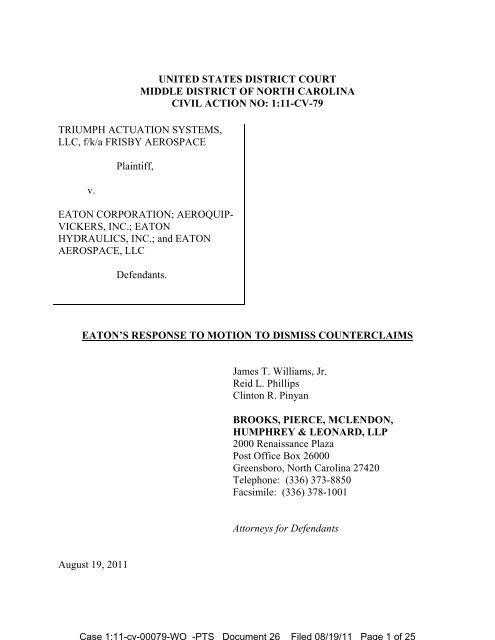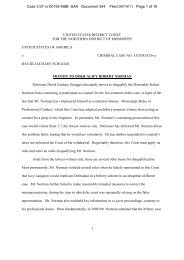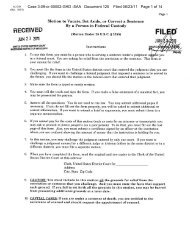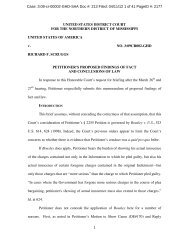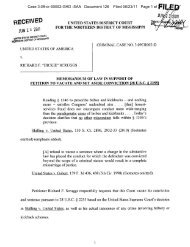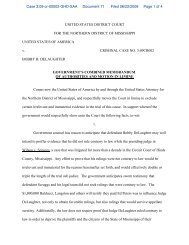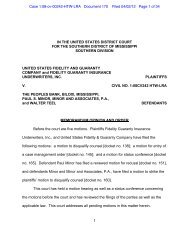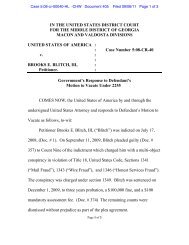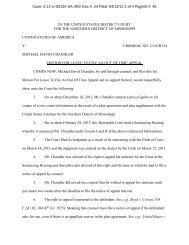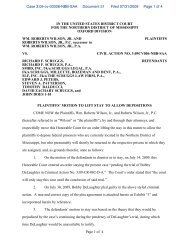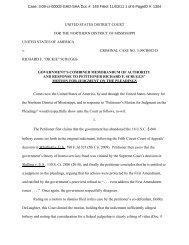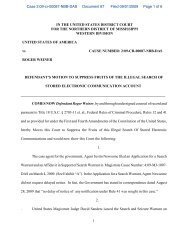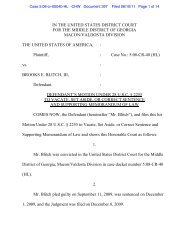Frisby response motion dismiss - NMissCommentor
Frisby response motion dismiss - NMissCommentor
Frisby response motion dismiss - NMissCommentor
Create successful ePaper yourself
Turn your PDF publications into a flip-book with our unique Google optimized e-Paper software.
UNITED STATES DISTRICT COURT<br />
MIDDLE DISTRICT OF NORTH CAROLINA<br />
CIVIL ACTION NO: 1:11-CV-79<br />
TRIUMPH ACTUATION SYSTEMS,<br />
LLC, f/k/a FRISBY AEROSPACE<br />
v.<br />
EATON’S RESPONSE TO MOTION TO DISMISS COUNTERCLAIMS<br />
August 19, 2011<br />
Plaintiff,<br />
EATON CORPORATION; AEROQUIP-<br />
VICKERS, INC.; EATON<br />
HYDRAULICS, INC.; and EATON<br />
AEROSPACE, LLC<br />
Defendants.<br />
James T. Williams, Jr.<br />
Reid L. Phillips<br />
Clinton R. Pinyan<br />
BROOKS, PIERCE, MCLENDON,<br />
HUMPHREY & LEONARD, LLP<br />
2000 Renaissance Plaza<br />
Post Office Box 26000<br />
Greensboro, North Carolina 27420<br />
Telephone: (336) 373-8850<br />
Facsimile: (336) 378-1001<br />
Attorneys for Defendants<br />
Case 1:11-cv-00079-WO -PTS Document 26 Filed 08/19/11 Page 1 of 25
TABLE OF CONTENTS<br />
TABLE OF AUTHORITIES ..............................................................................................ii<br />
INTRODUCTION AND STATEMENT OF THE MATTER BEFORE THE COURT .... 1<br />
STATEMENT OF FACTS.................................................................................................. 2<br />
QUESTIONS PRESENTED ............................................................................................... 5<br />
ARGUMENT ...................................................................................................................... 5<br />
I. THE COURT SHOULD DENY THE MOTION TO DISMISS BECAUSE<br />
THERE ARE SUBSTANTIAL QUESTIONS OF FACT ABOUT WHETHER, AND<br />
TO WHAT EXTENT, THE DEFENSE OF RES JUDICATA APPLIES. ..................... 6<br />
A. There Are Substantial Questions of Fact as to Whether Eaton Received a Full<br />
and Fair Opportunity to Litigate Its Claims in the Mississippi State Court......... 6<br />
B. The Motion to Dismiss Should Be Denied Because Eaton Has Alleged Claims<br />
After the Filing of the Mississippi Trade Secrets Litigation.............................. 13<br />
II. THE COURT SHOULD NOT DISMISS THE COUNTERCLAIMS AS<br />
DUPLICATIVE, IN LIGHT OF THE FACT THAT FRISBY ITSELF HAS FILED<br />
THE SAME CLAIMS IN FOUR SEPARATE LAWSUITS........................................ 16<br />
CONCLUSION ................................................................................................................. 20<br />
Case 1:11-cv-00079-WO -PTS Document 26 Filed 08/19/11 Page 2 of 25
TABLE OF AUTHORITIES<br />
Cases<br />
Barrett v. Jones, Funderburg, Sessums, Peterson & Lee, LLC, 27 So.3d 363<br />
(Miss. 2009) ................................................................................................................... 12<br />
Bogard v. Cook, 586 F.2d 399 (5th Cir. 1978).................................................................... 8<br />
Brooks v. Arthur, 626 F.3d 194 (4th Cir. 2010).................................................................. 6<br />
Bucklew v. State, 209 So.2d 916 (Miss. 1968) ................................................................. 12<br />
Cellar Door Prods., Inc. v. Kay, 897 F.2d 1375 (6th Cir. 1990) ....................................... 13<br />
Clorox Co. v. Winthrop, 836 F. Supp. 983 (E.D.N.Y. 1993)............................................ 13<br />
Curcio v. Hartford Fin. Serv. Group, 472 F. Supp.2d 239 (D. Conn. 2007)..................... 18<br />
EMC Mortgage Corp. v. Carmichael, 17 So.3d 1087 (Miss. 2009).................................... 8<br />
Groesch v. City of Springfield, 635 F.3d 1020 (7th Cir. 2011) ........................................ 14<br />
Handy v. Shaw, Bransford, Veilleux & Roth, 325 F.3d 346 (D.C. Cir. 2003) ................. 18<br />
Harkins Amusement Enters., Inc. v. Harry Nace Co., 890 F.2d 181 (9th Cir. 1989) ....... 13<br />
Holland v. Kohn, 12 Fed. Appx. 160 (4th Cir. 2001) ......................................................... 8<br />
Intermedics, Inc. v. Ventritex, Inc., 804 F. Supp. 35 (N.D. Cal. 1992) ............................ 14<br />
Junction Solutions, LLC v. MBS Dev., Inc., No. 06 C 1632, 2007 WL 4233995<br />
(N.D. Ill. Nov. 21, 1997)................................................................................................ 14<br />
Kremer v. Chemical Constr. Corp., 456 U.S. 461 (1982) ................................................6-7<br />
Lawlor v. National Screen Serv. Corp., 349 U.S. 322 (1955)........................................... 13<br />
Lee v. Winston, 717 F.2d 888 (4th Cir. 1983) .................................................................6-7<br />
Lorusso v. United States, No. 94-11713-NG, 1995 WL 606009<br />
(D. Mass. July 21, 1995)................................................................................................ 19<br />
Manning v. City of Auburn, 953 F.2d 1355 (11th Cir. 1992) ........................................... 14<br />
Marcum v. Mississippi Valley Gas Co., 672 So.2d 730 (Miss. 1996)................................ 8<br />
Melvin v. State, 48 So.2d 856 (Miss. 1950)...................................................................... 12<br />
Mississippi Employment Sec. Comm'n v. Philadelphia Mun. Separate Sch. Dist.,<br />
437 So.2d 388 (Miss. 1983)............................................................................................. 8<br />
Montana v. United States, 440 U.S. 147 (1979).................................................................. 7<br />
Morgan v. Covington Twp., F.3d , 2011 WL 3276012 (3rd Cir. Aug. 2, 2011).... 14<br />
Pleming v. Universal-Rundle Corp., 142 F.3d 1354 (11th Cir. 1998) .............................. 14<br />
Q Int'l Courier, Inc. v. Smoak, 441 F.3d 214 (4th Cir. 2006) ............................................. 6<br />
Remington Arms Co. v. Alliant Techsystems, Inc., No. 1:03-cv-1051,<br />
2004 WL 444574 (M.D.N.C. Feb. 25, 2004) ................................................................ 18<br />
Richmond, Fredericksburg & Potomac R. Co. v. Forst, 4 F.3d 244 (4th Cir. 1993) ...... 2, 6<br />
Save Power Ltd. v. Syntek Fin. Corp., 121 F.3d 947 (5th Cir. 1997)............................... 18<br />
Serlin v. Arthur Anderson & Co., 3 F.3d 221 (7th Cir. 1993) .......................................... 16<br />
Stanton v. D.C. Ct. of App., 127 F.3d 72 (D.C. Cir. 1997)............................................... 13<br />
Winston v. Lee, 470 U.S. 753 (1985).................................................................................. 7<br />
ii<br />
Case 1:11-cv-00079-WO -PTS Document 26 Filed 08/19/11 Page 3 of 25
Young-Henderson v. Spartanburg Area Mental Health Ctr., 945 F.2d 770<br />
(4th Cir. 1991)................................................................................................................ 14<br />
Statutes<br />
28 U.S.C. § 1738 ................................................................................................................. 6<br />
Rules<br />
Fed. R. Civ. P. 8................................................................................................................... 5<br />
Fed. R. Civ. P. 12............................................................................................................... 19<br />
Local Rule 7.2..................................................................................................................................2<br />
Treatises and Other Sources<br />
Restatement (2d) of Judgments § 24 ................................................................................. 13<br />
Charles Alan Wright and Arthur R. Miller, 5B Federal Practice & Procedure § 1357<br />
(3d ed. 2004) ................................................................................................................ 19<br />
iii<br />
Case 1:11-cv-00079-WO -PTS Document 26 Filed 08/19/11 Page 4 of 25
INTRODUCTION AND STATEMENT OF<br />
THE MATTER BEFORE THE COURT<br />
The counterclaims of Eaton Corporation and its related companies (“Eaton”) arise<br />
from a theft of trade secrets by <strong>Frisby</strong> Aerospace, Inc, now known as Triumph Actuation<br />
Systems, LLC (“<strong>Frisby</strong>”). The scope of that theft was uncovered in large part by a search<br />
warrant issued by this Court, and led to the indictment of five of Eaton’s former<br />
engineers in the Southern District of Mississippi and their prosecution in cases that are<br />
still pending to this day, notwithstanding seventeen <strong>motion</strong>s to <strong>dismiss</strong>. (Case Nos.<br />
3:06-cr-210 and 3:09-cr-6 (S.D. Miss.).)<br />
Eaton filed civil claims in Mississippi state court related to these thefts.<br />
Unfortunately, the merits of Eaton’s affirmative claims have never been evaluated by any<br />
court or ultimate trier of fact. Instead, in a procedurally flawed decision, which is<br />
currently on appeal, the Mississippi state court <strong>dismiss</strong>ed those claims as a sanction.<br />
The <strong>dismiss</strong>al prompted <strong>Frisby</strong>, over the course of 26 days, to file claims in four<br />
separate lawsuits alleging that Eaton engaged in sham and abusive litigation to gain a<br />
competitive advantage over <strong>Frisby</strong>. This assertion of sham and abusive litigation is<br />
outrageous in light of <strong>Frisby</strong>’s unclean hands as a result of its massive theft of trade<br />
secrets, which led not only to Eaton’s seeking redress in a civil action but also resulted in<br />
the pending criminal charges against <strong>Frisby</strong>’s engineers. Eaton responded to these claims<br />
with defenses and counterclaims that will demonstrate that <strong>Frisby</strong>’s allegations are<br />
patently untrue and that Eaton had, and still has, meritorious trade secret and related<br />
claims.<br />
Case 1:11-cv-00079-WO -PTS Document 26 Filed 08/19/11 Page 5 of 25
<strong>Frisby</strong> has moved to <strong>dismiss</strong> those counterclaims, alleging both that they are res<br />
judicata and that they are duplicative of counterclaims made in <strong>response</strong> to <strong>Frisby</strong>’s own<br />
duplicative claims. The Court should deny the <strong>motion</strong> to <strong>dismiss</strong>. There is (at a<br />
minimum) a material question of fact whether Eaton received a full and fair opportunity<br />
to litigate its claims in Mississippi, in light of serious procedural due process problems.<br />
The factual issues are more difficult to resolve at this stage because many of the relevant<br />
state court records are still under seal, preventing the Court from reviewing the<br />
procedural irregularities in Mississippi. Also, Eaton’s counterclaims allege that <strong>Frisby</strong><br />
has committed continuing wrongs that are not subject to res judicata. Finally, as <strong>Frisby</strong><br />
has caused the filing of four separate lawsuits, it is in no position to invoke any rule<br />
against duplicative litigation.<br />
STATEMENT OF FACTS<br />
Rather than responding to <strong>Frisby</strong>’s uncited and largely irrelevant “statement of<br />
facts,” 1 Eaton will limit its statement to the facts pertinent to the issues before the Court,<br />
with the understanding of the Court that most of <strong>Frisby</strong>’s statement of facts is disputed.<br />
1 The “statement of facts” in <strong>Frisby</strong>’s brief does not meet the requirements of this<br />
Court’s rules and the standards of a <strong>motion</strong> to <strong>dismiss</strong> under Rule 12(b)(6). Contrary to<br />
this Court’s rules, <strong>Frisby</strong>’s “statement of facts” contains scant “reference[s] to a part of<br />
the official record in this case,” much less a reference supporting “[e]ach statement of<br />
fact.” LR 7.2. As discussed later, <strong>Frisby</strong> can prevail on its <strong>motion</strong> to <strong>dismiss</strong> only if the<br />
res judicata defense “clearly appears on the face of the” counterclaims, Richmond,<br />
Fredericksburg & Potomac R. Co. v. Forst, 4 F.3d 244, 250 (4 th Cir. 1993), but the<br />
“facts” set out in <strong>Frisby</strong>’s brief do not appear in the counterclaims and thus cannot be<br />
considered on this <strong>motion</strong> to <strong>dismiss</strong>. Further, many of <strong>Frisby</strong>’s allegations are irrelevant<br />
to the limited res judicata issues presented and appear to have been offered for their<br />
(continued)<br />
- 2 -<br />
Case 1:11-cv-00079-WO -PTS Document 26 Filed 08/19/11 Page 6 of 25
In May 2003, the U.S. Attorney’s office for the Southern District of Mississippi<br />
and the Federal Bureau of Investigation began investigating the theft of trade secrets by<br />
engineers that <strong>Frisby</strong> had recruited to leave Eaton. (Docket 14, at 42 (( 70).) In January<br />
2004, Magistrate Judge Sharp of this Court approved a search warrant that yielded<br />
thousands of Eaton documents in <strong>Frisby</strong>’s possession at its Clemmons, North Carolina<br />
facility, and led to many admissions by the engineers. (Id. ( 70-78).)<br />
On July 9, 2004, Eaton filed a complaint in Mississippi state court against <strong>Frisby</strong><br />
and related individuals and entities, including Billy Grayson, James Ward, Kevin Clark,<br />
Michael Fulton, Rodney Case and Doug Murphy (“the Engineers”) asserting claims for,<br />
among other things, misappropriation of trade secrets, unfair competition, fraud and<br />
tortious interference with contract. (Docket 22-1.) The case was assigned to Hinds<br />
County Circuit Judge Bobby DeLaughter. (See Docket 22-5, at 2.) On September 29,<br />
2004, <strong>Frisby</strong> filed an answer and counterclaims, including counterclaims alleging that<br />
Eaton was engaging in sham and abusive litigation. (See Ex. 1).)<br />
On December 20, 2006, five of the Engineers were indicted, and those criminal<br />
charges are still pending in the Southern District of Mississippi. The indictments have<br />
been repeatedly reviewed and evaluated by the court and have survived seventeen<br />
separate <strong>motion</strong>s to <strong>dismiss</strong>. (Case Nos. 3:06-cr-210 and 3:09-cr-6 (S.D. Miss.).)<br />
prejudicial effect. For example, <strong>Frisby</strong> talks at length about alleged discovery violations<br />
regarding Milan Georgeoff (Br. at 4-5), although the December 22, 2010 order at issue<br />
expressly found that those issues “are not relevant to the issue of sanctions and/or<br />
<strong>dismiss</strong>al before the Court” (Docket 22-5 at 10).<br />
- 3 -<br />
Case 1:11-cv-00079-WO -PTS Document 26 Filed 08/19/11 Page 7 of 25
In December 2006, with the case still in the early stages of discovery, Eaton<br />
retained Ed Peters, the former Hinds County District Attorney, as well as two other<br />
Mississippi attorneys -- Fred Banks and Rueben Anderson of Phelps Dunbar, both of<br />
whom are former Mississippi Supreme Court Justices -- to represent Eaton in the case.<br />
On January 4, 2008, Judge DeLaughter recused himself from Eaton's case, and<br />
Hinds County Chief Circuit Judge Swan Yerger then assigned the case to himself. (See<br />
Docket 22-5 at 3.) Three weeks later, on January 24, 2008, <strong>Frisby</strong> and the Engineers<br />
filed a <strong>motion</strong> requesting that the court allow them to initiate an inquiry on whether Ed<br />
Peters engaged in improper ex parte communications with Judge DeLaughter concerning<br />
Eaton’s case. (See id.) The court acquiesced to the request and, on March 7, 2008, it<br />
entered an order staying discovery, noting its intent to conduct an inquiry into alleged ex<br />
parte communications between Peters and DeLaughter. (See id. at 4.)<br />
At the close of the inquiry, almost three years later, on December 22, 2010, Judge<br />
Yerger <strong>dismiss</strong>ed Eaton’s case as a sanction. (See id.) He did so based on a finding that<br />
he had rendered -- 18-months previously -- that Eaton knew or should have known that<br />
its local counsel Ed Peters had improper ex parte communications with Judge<br />
DeLaughter. (See id. at 12.) He held no evidentiary hearing before levying this sanction.<br />
(See id. at 7.) It is this December 22 ruling that <strong>Frisby</strong> claims precludes the<br />
counterclaims in this case.<br />
Eaton promptly appealed the December 22 ruling. Soon after that, within a span<br />
of 26 days, <strong>Frisby</strong> filed: (1) proposed amended counterclaims in the pending Mississippi<br />
- 4 -<br />
Case 1:11-cv-00079-WO -PTS Document 26 Filed 08/19/11 Page 8 of 25
state court action (Ex. 2); (2) a second, separate Mississippi state court action under 42<br />
U.S.C. § 1983 (Ex. 3), which has subsequently been removed; (3) a third, separate<br />
Mississippi state court action alleging various state law and Lanham Act claims (Ex. 4);<br />
and (4) this fourth, separate federal antitrust action in North Carolina. All four sets of<br />
<strong>Frisby</strong>’s claims are based on the same facts.<br />
During the course of all of this pending litigation since July of 2004, Eaton alleges<br />
that <strong>Frisby</strong> has continued to engage in trade secrets violations (Docket 14, at 44-45<br />
( 88-92), and continued related acts of conversion (id. at 51 ( 122-25)), tortious<br />
interference (id. at 52 ( 129)) and unfair competition (id. ( 132-25).<br />
QUESTIONS PRESENTED<br />
Should A Motion To Dismiss Be Granted On The Affirmative Defense Of Res<br />
Judicata When (A) There Are Substantial Questions Of Fact About Whether<br />
Eaton Had A Full And Fair Opportunity To Litigate Its Case And (B) Eaton<br />
Has Alleged Violations Subsequent To The Complaint Filed In The Prior<br />
Litigation?<br />
Should A Motion To Dismiss Be Granted On The Grounds That Eaton First<br />
Filed These Counterclaims Elsewhere, When <strong>Frisby</strong> Has Filed The Same<br />
Claims In Four Separate Lawsuits?<br />
ARGUMENT<br />
<strong>Frisby</strong> has a high burden to prevail on a <strong>motion</strong> to <strong>dismiss</strong> based on res judicata.<br />
Res judicata is an affirmative defense. Fed. R. Civ. P. 8(c)(1). “A <strong>motion</strong> under<br />
Rule 12(b)(6) is intended to test the legal adequacy of the [counterclaims], and not to<br />
address the merits of any affirmative defenses. In the limited circumstances where the<br />
allegations of the [counterclaims] give rise to an affirmative defense, the defense may be<br />
raised under Rule 12(b)(6), but only if it clearly appears on the face of the<br />
- 5 -<br />
Case 1:11-cv-00079-WO -PTS Document 26 Filed 08/19/11 Page 9 of 25
[counterclaims].” Richmond, Fredericksburg & Potomac R. Co. v. Forst, 4 F.3d 244, 250<br />
(4 th Cir. 1993) (refusing to grant <strong>motion</strong> to <strong>dismiss</strong> based on res judicata). <strong>Frisby</strong> bears<br />
the burden to prove the defense of res judicata. Q Int’l Courier, Inc. v. Smoak, 441 F.3d<br />
214, 219 (4 th Cir. 2006). In ruling on a 12(b)(6) <strong>motion</strong> based on res judicata, the Court<br />
must accept the claims’ factual allegations as true. Brooks v. Arthur, 626 F.3d 194, 200<br />
(4 th Cir. 2010). While the Court may take judicial notice of prior proceedings, it may not<br />
do so if there are disputed issues of fact. Id.; Q Int’l, 441 F.3d at 216. Here, substantial<br />
questions of fact indicate that <strong>Frisby</strong>’s <strong>motion</strong> to <strong>dismiss</strong> should be denied.<br />
I. THE COURT SHOULD DENY THE MOTION TO DISMISS<br />
BECAUSE THERE ARE SUBSTANTIAL QUESTIONS OF FACT ABOUT<br />
WHETHER, AND TO WHAT EXTENT, THE DEFENSE OF RES JUDICATA<br />
APPLIES.<br />
A. There Are Substantial Questions of Fact as to Whether Eaton Received<br />
a Full and Fair Opportunity to Litigate Its Claims in the Mississippi<br />
State Court.<br />
<strong>Frisby</strong>’s brief is silent as to two related, significant areas of factual dispute that<br />
cannot be resolved on the face of the counterclaims.<br />
First, the full faith and credit statute, 28 U.S.C. § 1738, provides for federal courts<br />
to give preclusive effect to state court judgments. But there is a crucial prerequisite to the<br />
application of that statute: The Court is not to give preclusive effect if the claimant did<br />
not have a “full and fair opportunity” to litigate the claim in state court. Kremer v.<br />
Chemical Constr. Corp., 456 U.S. 461, 480-81 (1982); Lee v. Winston, 717 F.2d 888, 894<br />
(4 th Cir. 1983), aff’d, 470 U.S. 753 (1985). “Redetermination of issues is warranted if<br />
there is reason to doubt the quality, extensiveness, or fairness of procedures followed in<br />
- 6 -<br />
Case 1:11-cv-00079-WO -PTS Document 26 Filed 08/19/11 Page 10 of 25
prior litigation.” Kremer, 456 U.S. at 481; Montana v. United States, 440 U.S. 147, 164<br />
n. 11 (1979). “The State must . . . satisfy the applicable requirements of the Due Process<br />
Clause. A State may not grant preclusive effect in its own courts to a constitutionally<br />
infirm judgment, and other state and federal courts are not required to accord full faith<br />
and credit to such a judgment.” Kremer, 456 U.S. at 482; see Lee, 717 F.2d at 894.<br />
In Lee v. Winston, the Fourth Circuit declined to give full faith and credit to a<br />
state court ruling that it found failed to allow for a “full and fair opportunity” to litigate<br />
the issues, even if the ruling otherwise met all of the other requirements for preclusive<br />
effect. 717 F.2d at 895 (“Assuming . . . without deciding, that the state court order here<br />
. . . would ordinarily be given preclusive effect by Virginia courts, we nevertheless<br />
decline to give it such effect in this case. Under § 1738, we are required to give state<br />
proceedings full faith and credit only if – all other state law predicates for issue<br />
preclusion being present – those proceedings satisfy the minimum procedural due process<br />
requirements of the fourteenth amendment.”). The Lee Court did so following full<br />
development of a record on what occurred during the state court proceeding, so that the<br />
Lee Court could make findings on whether there had been a full and fair opportunity to<br />
litigate. See id. at 896-99 (denial of continuance deprived party of full and fair<br />
opportunity to litigate); Winston v. Lee, 470 U.S. 753, 758 n.3 (1985) (in Supreme Court,<br />
party did not dispute that there had been no full and fair opportunity to litigate). Where a<br />
party raises a factual issue regarding whether it had a “full and fair opportunity” to<br />
litigate, such an issue precludes summary judgment, much less <strong>dismiss</strong>al pursuant to<br />
- 7 -<br />
Case 1:11-cv-00079-WO -PTS Document 26 Filed 08/19/11 Page 11 of 25
Rule 12(b)(6). See, e.g., Holland v. Kohn, 12 Fed. Appx. 160, 166-67 (4 th Cir. 2001)<br />
(reversing district court’s preclusion determination and refusing to find preclusion from<br />
<strong>dismiss</strong>al order entered as discovery sanction).<br />
Second, Mississippi law incorporates similar principles precluding res judicata<br />
when the party against whom preclusion is sought has not been given a fair chance to<br />
present its case. EMC Mortgage Corp. v. Carmichael, 17 So.3d 1087, 1091 (Miss. 2009)<br />
(applying Kremer, supra). Moreover, Mississippi courts are particularly reluctant to<br />
prevent the full litigation of factual disputes:<br />
[T]he doctrine of collateral estoppel must never be seen as anything other<br />
than an unusual exception to the general rule that all fact questions should<br />
be litigated fully in each case. . . . Where there is room for suspicion<br />
regarding the reliability of those first fact findings, collateral estoppel<br />
should never be applied.<br />
Mississippi Employment Sec. Comm’n v. Philadelphia Mun. Separate Sch. Dist., 437<br />
So.2d 388, 397 (Miss. 1983); Marcum v. Mississippi Valley Gas Co., 672 So.2d 730, 733<br />
(Miss. 1996); see also Bogard v. Cook, 586 F.2d 399, 408 (5 th Cir. 1978) (“Principles of<br />
res judicata are not ironclad.”).<br />
Here, the Court cannot decide that Eaton’s claims are barred by res judicata, as a<br />
matter of law on the pleadings, because there is a factual dispute about whether Eaton had<br />
a full and fair opportunity to litigate the matters in the Mississippi trade secret litigation.<br />
In its counterclaims, Eaton affirmatively raises the issue that Eaton was denied due<br />
process in the Mississippi lawsuit, so that res judicata should not apply. (Docket 14, at<br />
- 8 -<br />
Case 1:11-cv-00079-WO -PTS Document 26 Filed 08/19/11 Page 12 of 25
30 ( 2).) With Eaton having raised that factual question, <strong>Frisby</strong> is not in a position to<br />
prevail on its <strong>motion</strong> to <strong>dismiss</strong>.<br />
Even if <strong>Frisby</strong> were to argue – contrary to the law – that the Court can weigh the<br />
facts at this stage, the Court is not in a position to do so. Determining that Eaton failed to<br />
receive due process will require review of the Mississippi court’s actions at several points<br />
over a period of years. Furthermore, many of the documents necessary to that review are<br />
not on the public record, but instead are under seal. On September 22, 2009, the<br />
Mississippi court entered an order designating the vast majority of the documents related<br />
to the “ex parte investigation” as “restricted,” and hence sealed. (Ex. 5.) Those<br />
documents have remained under seal, pending further review to determine which<br />
documents may be unsealed. (Ex. 6 & 7.) 2 The Mississippi court still may unseal those<br />
records or permit this Court to review them under seal. It has done that to permit the use<br />
of the documents in the criminal proceedings that still remain pending against five of<br />
plaintiff’s engineers. (See Ex. 5 & 8.) But it has not yet done so to permit disclosure<br />
here. On this record, without proof of the procedural fairness of the December 22<br />
rulings, the <strong>motion</strong> to <strong>dismiss</strong> should be denied. 3<br />
2 Although the Special Master has made a recommendation about the documents to<br />
remain under seal – which recommendation is itself under seal – the Court has not yet<br />
ruled on the recommendation and unsealed any documents.<br />
3 It cannot be said that the public record is so clear as to justify <strong>dismiss</strong>al of the<br />
counterclaim on the pleadings under Rule 12(b)(6). Moreover, this Court should not opt<br />
to convert the <strong>motion</strong> to <strong>dismiss</strong> to a <strong>motion</strong> to summary judgment and, if it does,<br />
pursuant to Rule 56(d), Eaton requests that, at a minimum, the Court defer ruling until the<br />
(continued)<br />
- 9 -<br />
Case 1:11-cv-00079-WO -PTS Document 26 Filed 08/19/11 Page 13 of 25
Furthermore, the December 22 order itself displays significant procedural<br />
deficiencies. The opinion reveals that <strong>Frisby</strong> first alleged “improprieties regarding the<br />
relationship of then-Judge DeLaughter and Ed Peters on January 24, 2008.” (Docket<br />
22-5 at 3.) On March 7, 2008, the court announced its “intent to conduct an inquiry into<br />
alleged ex parte communications between Peters and DeLaughter.” (Id. at 4.)<br />
On June 19, 2009, the inquiry into the alleged ex parte contacts was still ongoing:<br />
• The parties were in the process of written discovery and document<br />
production.<br />
• The first deposition of any substantive witness had yet to be taken.<br />
• <strong>Frisby</strong> had not yet filed the <strong>motion</strong> to <strong>dismiss</strong> that gave rise to the<br />
December 22 order.<br />
Yet, on June 19, 2009, the Court entered an order that it subsequently characterized as<br />
finding as a fact that Eaton “either knew or reasonably should have known of the ongoing<br />
fraud perpetrated by Peters.” (Id. at 5.) That June 19, 2009 order forms much of the<br />
“factual” predicate for the December 22 order; the December 22 order says that, “[i]n this<br />
Court’s opinion, the clear language from the June 19, 2009, Opinion/Order, as cited<br />
above, supports the premise that the Court has already made that determination” whether<br />
the alleged ex parte contacts occurred and whether they constitute a fraud. (Id. at 12<br />
(emphasis added).) Moreover, that June 19, 2009 order is itself under seal so that the<br />
Court cannot review the basis for the determination that Eaton should have known of<br />
parties can approach the Mississippi court to authorize this Court to review the relevant<br />
portions of the record.<br />
- 10 -<br />
Case 1:11-cv-00079-WO -PTS Document 26 Filed 08/19/11 Page 14 of 25
Peters’ actions. (Ex. 9.) But it is clear from the meager public record that this purported<br />
“factual” finding was made before any facts had actually been developed.<br />
In addition, the slim record that is available to this Court reveals that the<br />
Mississippi court proceeded to use the basis for this pre-discovery finding of “fact” to<br />
<strong>dismiss</strong> all of Eaton’s claims without providing Eaton with an opportunity for an<br />
evidentiary hearing. The December 22 order candidly reveals that Eaton repeatedly<br />
demanded and was denied an evidentiary hearing concerning the charges against it: “The<br />
Plaintiffs have continued to make requests for an evidentiary hearing before this judge,<br />
despite the Court’s repeated rulings that such a hearing was unnecessary and not in the<br />
interest of judicial economy.” (Docket 22-5 at 7.)<br />
And, not only did the Mississippi court refuse to conduct an evidentiary hearing to<br />
resolve disputed issues of fact, but the court stated that it was acting on the basis of<br />
documents that, to this day, the parties have never seen. In its December 22 order, the<br />
Court approved the Special Master’s Report and Recommendation of November 25,<br />
2009, another document which remains under seal. In so doing, the Court declared:<br />
After due consideration, the Court finds that the November 25, 2009 Report<br />
and Recommendation of the Special Master is hereby accepted as findings<br />
of fact, only as it relates to the Special Master’s findings at the various<br />
depositions. This ruling particularly includes the deposition summaries and<br />
observations of credibility made by the Special Master regarding the<br />
witnesses, either in the report or in the attached summaries.<br />
(Id. at 8 (emphasis added).) No deposition summaries were attached to the report and<br />
recommendation served upon the parties, nor do they otherwise appear on the Circuit<br />
- 11 -<br />
Case 1:11-cv-00079-WO -PTS Document 26 Filed 08/19/11 Page 15 of 25
Court’s docket. (Ex. 10.) Certainly, it would be irregular to apply res judicata on the<br />
basis of factual findings not known even to the parties, much less to this Court.<br />
Where allegations are made on the serious charges that a party has attempted to<br />
corrupt the administration of justice, Mississippi courts have required heightened<br />
procedural protections, rather than lessened ones. Reported decisions have treated such<br />
inquiries as criminal contempt proceedings, entitling the accused to all the protections<br />
provided in such cases. See, e.g., Bucklew v. State, 209 So.2d 916, 917 (Miss. 1968);<br />
Melvin v. State, 48 So.2d 856 (Miss. 1950), suggestion of error overruled, 49 So.2d 837<br />
(Miss. 1951). These procedures are not an antiquated artifact. In April of 2008, the<br />
Mississippi state court -- although it did not institute a criminal contempt proceeding --<br />
still employed similar procedures in a civil context to investigate allegations of judicial<br />
bribery. To resolve the matter, the court held a full evidentiary hearing. Barrett v. Jones,<br />
Funderburg, Sessums, Peterson & Lee, LLC, 27 So.3d 363, 367-68 (Miss. 2009).<br />
The December 22 rulings display none of these safeguards. The Mississippi court<br />
made the crucial factual findings of alleged wrongdoing on June 19, 2009, over five<br />
months before <strong>Frisby</strong> ever filed its <strong>motion</strong> to <strong>dismiss</strong> on these subjects, while<br />
document discovery was still ongoing on the facts, and before any substantive<br />
witness depositions were taken. The court admitted that it had denied Eaton the<br />
opportunity to present testimony to the finder of fact. Eaton never had the opportunity to<br />
respond to the deposition summaries, which it still has never seen. And these are just the<br />
procedural irregularities apparent on the face of the order itself; Eaton submits that it will<br />
- 12 -<br />
Case 1:11-cv-00079-WO -PTS Document 26 Filed 08/19/11 Page 16 of 25
demonstrate several other irregularities in the sealed portion of the record. In Eaton’s<br />
estimation, all of these procedural flaws establish that Eaton was not provided with a fair<br />
opportunity to litigate the issues. Certainly – at a minimum – they reveal substantial<br />
factual questions that cannot be resolved in this <strong>motion</strong> to <strong>dismiss</strong> on this record.<br />
B. The Motion to Dismiss Should Be Denied Because Eaton Has Alleged<br />
Claims After the Filing of the Mississippi Trade Secrets Litigation.<br />
The <strong>motion</strong> to <strong>dismiss</strong> also should be denied because Eaton has alleged claims<br />
following the filing of the Mississippi trade secrets litigation. Res judicata applies only<br />
as to complaints that allege the “same cause of action,” and therefore does not bar claims<br />
arising from conduct that occurred following the prior litigation. See Lawlor v. National<br />
Screen Serv. Corp., 349 U.S. 322, 327-328 (1955). “That both suits involved ‘essentially<br />
the same course of wrongful conduct’ is not decisive.” Id. at 327.<br />
Therefore, even if conduct was set in <strong>motion</strong> before the prior action, the<br />
continuation of the wrong gives rise to a different cause of action, for res judicata<br />
purposes. This is true regardless of “whether the defendants’ conduct be regarded as a<br />
series of individual torts or as one continuing tort.” Id. at 328 Thus, res judicata does not<br />
bar new claims arising from a continuing wrong, such as continuing abatable nuisance,<br />
see id. at 327-28, continuing antitrust conspiracy or other antitrust violations, id. at 328;<br />
Cellar Door Prods., Inc. v. Kay, 897 F.2d 1375, 1377-78 (6 th Cir. 1990); Harkins<br />
Amusement Enters., Inc. v. Harry Nace Co., 890 F.2d 181, 183 (9 th Cir. 1989); Clorox<br />
Co. v. Winthrop, 836 F. Supp. 983, 994 (E.D.N.Y. 1993); Restatement (2d) of Judgments<br />
§ 24, ill. 12, continuing application of unconstitutional regulations, Stanton v. D.C. Ct. of<br />
- 13 -<br />
Case 1:11-cv-00079-WO -PTS Document 26 Filed 08/19/11 Page 17 of 25
App., 127 F.3d 72, 78-79 (D.C. Cir. 1997), or continuing pay discrimination, Groesch v.<br />
City of Springfield, 635 F.3d 1020, 1029-30 (7 th Cir. 2011). Under these principles, the<br />
continued misappropriation and use of trade secrets (even the same trade secrets at issue<br />
in the former action) may give rise to a new cause of action that is not barred by res<br />
judicata. See, e.g., Junction Solutions, LLC v. MBS Dev., Inc., No. 06 C 1632, 2007 WL<br />
4233995 (N.D. Ill. Nov. 21, 1997); Intermedics, Inc. v. Ventritex, Inc., 804 F. Supp. 35<br />
(N.D. Cal. 1992). Intermedics stressed that it requires a “systematic comparison of the<br />
facts” to determine whether the subsequent actions are sufficiently related to the prior<br />
actions to be barred by res judicata, making it difficult to decide on summary judgment,<br />
much less a <strong>motion</strong> to <strong>dismiss</strong>. See 804 F. Supp. at 43.<br />
Moreover, every federal circuit court to have considered the issue has decided that<br />
res judicata bars only those claims “in existence at the time the original complaint is filed<br />
or claims actually asserted by supplemental pleadings or otherwise in earlier action.”<br />
Manning v. City of Auburn, 953 F.2d 1355, 1360 (11 th Cir. 1992); 4 see Morgan v.<br />
Covington Twp., F.3d , 2011 WL 3276012, at *4-*5 (3 rd Cir. Aug. 2, 2011) (“Five<br />
other Courts of Appeals have already adopted a bright-line rule that res judicata does not<br />
apply to events post-dating the filing of the initial complaint. . . . We see no reason to<br />
part with our sister Circuit Courts.”) (citing cases); Young-Henderson v. Spartanburg<br />
Area Mental Health Ctr., 945 F.2d 770, 774 (4 th Cir. 1991) (expressing doubt that res<br />
4 For a claim to be “otherwise” raised, it must be formally raised by supplemental<br />
or amended pleading or inclusion in a pretrial order. Pleming v. Universal-Rundle Corp.,<br />
142 F.3d 1354, 1358 (11 th Cir. 1998).<br />
- 14 -<br />
Case 1:11-cv-00079-WO -PTS Document 26 Filed 08/19/11 Page 18 of 25
judicata “was intended to preclude claims that could not have been brought at the time<br />
the first complaint was filed”). Mississippi has adopted no decisions rejecting that rule.<br />
Here, Eaton filed its original complaint in the Mississippi courts on July 9, 2004.<br />
(Docket 22-1.) Eaton never amended or supplemented that complaint. (See Ex. 10.)<br />
Thus, at most, res judicata might bar only those claims as of July 9, 2004.<br />
In its Counterclaims in this case, Eaton has alleged substantial trade secret<br />
violations and other state law claims following July 9, 2004. Eaton has alleged that, after<br />
the initial complaint, <strong>Frisby</strong> has used the significant number of trade secrets violations to<br />
maintain existing business in the aerospace industry and unlawfully compete for new<br />
business in that arena. (Docket 14 at 44-45 ( 78, 89-90).) The sole reason <strong>Frisby</strong> was<br />
able to so quickly compete with other aerospace manufacturers for potential aerospace<br />
business is because the engineers it hired from Eaton illegally took a large number of<br />
trade secrets with them when they joined <strong>Frisby</strong>. (Id. at 40-41 ( 67-69).)<br />
In 2002 and 2003, <strong>Frisby</strong> won three aerospace hydraulic motor contracts based on<br />
its use of stolen Eaton trade secrets. (Id. at 39 ( 55).) Eaton alleged, on information and<br />
belief, that <strong>Frisby</strong> continues to service those contracts to this day, including providing<br />
parts and components based upon Eaton trade secrets to those customers. (See id. at 45<br />
( 89-90).) <strong>Frisby</strong> further continues to use Eaton’s trade secrets to compete for new<br />
business in the aerospace industry. (See id. ( 91).) Moreover, Eaton has asserted related<br />
- 15 -<br />
Case 1:11-cv-00079-WO -PTS Document 26 Filed 08/19/11 Page 19 of 25
causes of action for <strong>Frisby</strong>’s conversion (id. at 51 ( 122-25)), tortious interference (id. at<br />
52 ( 129)), and unfair competition (id. ( 132)) occurring after the initial complaint. 5<br />
Even if res judicata applied to the claims as of the date of the original July 9, 2004<br />
complaint (which it does not), it would not bar the “continuing” claims. Accordingly,<br />
Eaton has stated valid claims for relief, and the <strong>motion</strong> to <strong>dismiss</strong> should be denied.<br />
II. THE COURT SHOULD NOT DISMISS THE COUNTERCLAIMS AS<br />
DUPLICATIVE, IN LIGHT OF THE FACT THAT FRISBY ITSELF HAS FILED<br />
THE SAME CLAIMS IN FOUR SEPARATE LAWSUITS.<br />
<strong>Frisby</strong> further argues that, even if Eaton’s Counterclaims are not barred by res<br />
judicata, the Court still should <strong>dismiss</strong> the Counterclaims under the first-filed rule,<br />
because those Counterclaims are similar to ones that Eaton filed in two similar lawsuits<br />
that were then pending in Mississippi federal court. (Br. at 14-15.) That argument is<br />
made with no apparent sense of irony although, if accepted, it would be a reason for<br />
<strong>dismiss</strong>ing <strong>Frisby</strong>’s Complaint, more so than Eaton’s Counterclaims.<br />
<strong>Frisby</strong> cites Serlin v. Arthur Anderson & Co., 3 F.3d 221 (7 th Cir. 1993), for the<br />
proposition that a federal court has the power to manage its docket to <strong>dismiss</strong> a suit<br />
“whenever it is duplicative of a parallel action already pending in another federal court.”<br />
(Br. at 14.) But this action is duplicative of the Mississippi federal actions – not because<br />
Eaton chose to litigate here – but because <strong>Frisby</strong> filed a duplicative complaint in this<br />
Court.<br />
5 In the event that the allegations in the Counterclaims are insufficiently detailed,<br />
Eaton should be allowed leave to amend the pleadings.<br />
- 16 -<br />
Case 1:11-cv-00079-WO -PTS Document 26 Filed 08/19/11 Page 20 of 25
On September 29, 2004, <strong>Frisby</strong> first filed counterclaims against Eaton in the<br />
Mississippi trade secret litigation based on allegations that Eaton was abusing that<br />
litigation for competitive purposes. (Ex. 1). On January 6, 2011, <strong>Frisby</strong> filed a <strong>motion</strong><br />
for leave to amend the counterclaims to add state law claims and a claim under 42 U.S.C.<br />
§ 1983 based on the same allegations raised in this Court. (Ex. 2). 6<br />
Notwithstanding those claims made in the original case, on January 28, 2011,<br />
<strong>Frisby</strong> filed two separate new actions in Mississippi state court making identical<br />
allegations to its Complaint here. In the first, <strong>Frisby</strong> asserts that these facts give rise to<br />
42 U.S.C. § 1983 claims. (Ex. 3.) Following removal, this case is pending in federal<br />
court, where <strong>Frisby</strong> later filed an amended complaint. (Ex. 12.) In the second (filed<br />
immediately after the first), <strong>Frisby</strong> asserted that these allegations also give rise to claims<br />
for unfair competition, torious interference, abuse of process, malicious prosecution,<br />
defamation, civil conspiracy and North Carolina unfair trade practice and Lanham Act<br />
violations. (Ex. 4.) After a detour to federal court, this second case is pending separately<br />
in Mississippi state court. 7 Along with the prior counterclaims in the original case, this<br />
brought <strong>Frisby</strong> to three separate lawsuits making the same claims.<br />
6 The Mississippi state court granted the <strong>motion</strong> to amend the counterclaims and,<br />
on March 21, 2011, <strong>Frisby</strong> filed supplemented and amended counterclaims. (Ex. 11.)<br />
7 This second simultaneous complaint was filed in what <strong>Frisby</strong> has acknowledged<br />
was an effort to split its federal and state law causes of action. But <strong>Frisby</strong> included the<br />
Lanham Act claim in its second complaint. So, Eaton removed that complaint as well.<br />
<strong>Frisby</strong> then filed an amended complaint to eliminate the Lanham Act claim (Ex. 13), and<br />
moved to remand that case because it had “inadvertently included” the Lanham Act claim<br />
(continued)<br />
- 17 -<br />
Case 1:11-cv-00079-WO -PTS Document 26 Filed 08/19/11 Page 21 of 25
Unsatisfied, <strong>Frisby</strong> filed a fourth lawsuit. On February 1, 2011, <strong>Frisby</strong> filed this<br />
federal antitrust action in this Court based on the same set of allegations.<br />
A second suit (or, here, fourth suit) is duplicative, even if the causes of action are<br />
different, if it arises out of the same transaction or series of transactions as the first<br />
lawsuit. Remington Arms Co. v. Alliant Techsystems, Inc., No. 1:03-cv-1051, 2004 WL<br />
444574, at *2 (M.D.N.C. Feb. 25, 2004); Handy v. Shaw, Bransford, Veilleux & Roth,<br />
325 F.3d 346, 349-50 (D.C. Cir. 2003); Save Power Ltd. v. Syntek Fin. Corp., 121 F.3d<br />
947, 950-51 (5 th Cir. 1997); Curcio v. Hartford Fin. Serv. Group, 472 F. Supp.2d 239,<br />
243 (D. Conn. 2007). A cursory examination of <strong>Frisby</strong>’s pleadings in the four cases<br />
demonstrates that <strong>Frisby</strong>’s claims in this case arise out of the same transactions alleged in<br />
the Mississippi state court counterclaims, the separate Mississippi state court action and<br />
the Mississippi federal case. Indeed, <strong>Frisby</strong> itself has acknowledged that “the substance”<br />
of its claims in the three Mississippi actions is “very similar.” (Ex. 14 at 7.) That is<br />
plainly true of this action as well.<br />
<strong>Frisby</strong>’s abusive actions in filing a duplicative fourth complaint here led Eaton to<br />
file its counterclaims in both Mississippi and North Carolina. <strong>Frisby</strong> cannot take<br />
advantage of its own duplicative pleading to claim that Eaton’s counterclaims – and only<br />
Eaton’s counterclaims – should be <strong>dismiss</strong>ed. None of the cases that <strong>Frisby</strong> cites on<br />
deference to first-filed litigation – and no cases of which Eaton is aware – support the<br />
(Ex. 14 at 1) and had intended to split its claims “so that the [second complaint] could not<br />
be removed to federal court” (id. at 7). On August 16, 2011, the Court remanded that<br />
case. (Ex. 15.)<br />
- 18 -<br />
Case 1:11-cv-00079-WO -PTS Document 26 Filed 08/19/11 Page 22 of 25
notion that the Court should <strong>dismiss</strong> only one party’s claims in deference to first-filed<br />
litigation, while allowing the other party’s duplicative claims to proceed in both courts<br />
(or, here, all three courts in four separate cases).<br />
This principle is particularly apt in this case, where fact discovery will be exactly<br />
the same, regardless of whether the counterclaims are <strong>dismiss</strong>ed. Here, Eaton’s defenses<br />
and counterclaims almost entirely overlap: <strong>Frisby</strong> claims that Eaton engaged in sham<br />
litigation, and both Eaton’s defenses and counterclaims will demonstrate that is patently<br />
untrue and that Eaton had, and still has, meritorious trade secret and related claims. The<br />
parties will undertake the same fact discovery on the nature of Eaton’s trade secret and<br />
related claims, whether or not the counterclaims remain in the case. This court has the<br />
discretion to postpone deciding the <strong>motion</strong> to <strong>dismiss</strong> until later in the proceedings.<br />
Charles Alan Wright and Arthur R. Miller, 5B Federal Practice & Procedure § 1357, at<br />
731 (3d ed. 2004); see Fed. R. Civ. P. 12(a)(4)(A) (contemplating that, upon Rule 12<br />
<strong>motion</strong>, court may “postpone[] its disposition until trial”). 8 In the event that the Court<br />
does not simply deny the <strong>motion</strong> to <strong>dismiss</strong>, it should permit the parties to proceed with<br />
discovery on the issues that will be in the case regardless, while postponing its ruling on<br />
this <strong>motion</strong>.<br />
8 Postponement of a ruling is appropriate here also, where the issues are currently<br />
on appeal in Mississippi and a decision may inform this Court’s decision about whether<br />
and to what extent the counterclaims are precluded. See, e.g., Lorusso v. United States,<br />
No. 94-11713-NG, 1995 WL 606009, at *2 (D. Mass. July 21, 1995).<br />
- 19 -<br />
Case 1:11-cv-00079-WO -PTS Document 26 Filed 08/19/11 Page 23 of 25
In short, <strong>Frisby</strong> has chosen to litigate in multiple courts, and Eaton is permitted to<br />
defend itself and file compulsory counterclaims in every court in which <strong>Frisby</strong> has filed<br />
its claims. Eaton is fully prepared to litigate the case that <strong>Frisby</strong> chose to file in this<br />
Court.<br />
CONCLUSION<br />
The <strong>motion</strong> to <strong>dismiss</strong> the counterclaims should be denied.<br />
Respectfully submitted, this the 19 th day of August, 2011.<br />
OF COUNSEL:<br />
BROOKS, PIERCE, MCLENDON,<br />
HUMPHREY & LEONARD, LLP<br />
2000 Renaissance Plaza<br />
Post Office Box 26000<br />
Greensboro, North Carolina 27420<br />
Telephone: (336) 373-8850<br />
Facsimile: (336) 378-1001<br />
/s/ James T. Williams, Jr.<br />
James T. Williams, Jr. (N.C. State Bar No. 4758)<br />
jwilliams@brookspierce.com<br />
Reid L. Phillips (N.C. State Bar No. 7968)<br />
rphillips@brookspierce.com<br />
Clinton R. Pinyan (N.C. State Bar. No. 22260)<br />
cpinyan@brookspierce.com<br />
Attorneys for Defendants<br />
- 20 -<br />
Case 1:11-cv-00079-WO -PTS Document 26 Filed 08/19/11 Page 24 of 25
CERTIFICATE OF SERVICE<br />
I hereby certify that, on August 19, 2011, I electronically filed the foregoing<br />
document with the Clerk of the Court using the CM/ECF system, which will send<br />
notification of such filing to the following:<br />
J. Donald Cowan, Jr. (don.cowan@elliswinters.com)<br />
Jonathan D. Sasser (jon.sasser@elliswinters.com)<br />
Curtis J. Shipley (curtis_shipley@elliswinters.com)<br />
Counsel for Plaintiff<br />
Respectfully Submitted,<br />
/s/ Clinton R. Pinyan<br />
Clinton R. Pinyan<br />
Case 1:11-cv-00079-WO -PTS Document 26 Filed 08/19/11 Page 25 of 25


